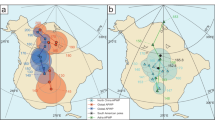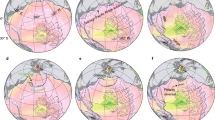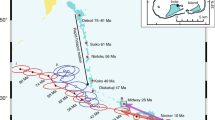Abstract
The motion of continents relative to the Earth’s spin axis may be due either to rotation of the entire Earth relative to its spin axis—true polar wander1,2—or to the motion of individual plates3. In order to distinguish between these over the past 320 Myr (since the formation of the Pangaea supercontinent), we present here computations of the global average of continental motion and rotation through time4 in a palaeomagnetic reference frame. Two components are identified: a steady northward motion and, during certain time intervals, clockwise and anticlockwise rotations, interpreted as evidence for true polar wander. We find ∼18° anticlockwise rotation about 250-220 Myr ago and the same amount of clockwise rotation about 195-145 Myr ago. In both cases the rotation axis is located at about 10-20° W, 0° N, near the site that became the North American–South American–African triple junction at the break-up of Pangaea. This was followed by ∼10° clockwise rotation about 145-135 Myr ago, followed again by the same amount of anticlockwise rotation about 110-100 Myr ago, with a rotation axis in both cases ∼25-50° E in the reconstructed area of North Africa and Arabia. These rotation axes mark the maxima of the degree-two non-hydrostatic geoid during those time intervals, and the fact that the overall net rotation since 320 Myr ago is nearly zero is an indication of long-term stability of the degree-two geoid and related mantle structure5,6. We propose a new reference frame, based on palaeomagnetism, but corrected for the true polar wander identified in this study, appropriate for relating surface to deep mantle processes from 320 Myr ago until hotspot tracks can be used (about 130 Myr ago).
This is a preview of subscription content, access via your institution
Access options
Subscribe to this journal
Receive 51 print issues and online access
$199.00 per year
only $3.90 per issue
Buy this article
- Purchase on Springer Link
- Instant access to full article PDF
Prices may be subject to local taxes which are calculated during checkout




Similar content being viewed by others
References
Gold, T. Instability of the Earth’s axis of rotation. Nature 175, 526–529 (1955)
Goldreich, P. & Toomre, A. Some remarks on polar wandering. J. Geophys. Res. 74, 2555–2569 (1969)
Wegener, A. The origin of the continents. J. Geodyn. 32, 29–63 (2001); Die Entstehung der Kontinente. Petermanns Geographische Mitteilungen 58(I), 185–195; 253–256; 305–309 (1912)
Jurdy, D. M. & Van Der Voo, R. True polar wander since the Early Cretaceous. Science 187, 1193–1196 (1975)
Evans, D. A. D. True polar wander and supercontinents. Tectonophysics 362, 303–320 (2003)
Torsvik, T. H., Smethurst, M. A., Burke, K. & Steinberger, B. Large igneous provinces generated from the margins of the large low-velocity provinces in the deep mantle. Geophys. J. Int. 167, 1447–1460 (2006)
Kirschvink, J. L., Ripperdan, R. L. & Evans, D. A. Evidence for a large-scale reorganization of Early Cambrian continental landmasses by inertial interchange true polar wander. Science 277, 541–545 (1997)
Mound, J. E., Mitrovica, J. X. & Milne, G. A. Sea-level change and true polar wander during the Late Cretaceous. Geophys. Res. Lett. 28, 2057–2060 (2001)
Torsvik, T. H., Van der Voo, R. & Redfield, T. F. Relative hotspot motions versus true polar wander. Earth Planet. Sci. Lett. 202, 185–200 (2002)
Maloof, A. C. et al. Combined paleomagnetic, isotopic, and stratigraphic evidence for true polar wander from the Neoproterozoic Akademikerbreen Group, Svalbard. Geol. Soc. Am. Bull. 118, 1099–1124 (2006)
Steinberger, B. & O’Connell, R. J. Changes of the Earth’s rotation axis owing to advection of mantle density heterogeneities. Nature 387, 169–173 (1997)
Steinberger, B. & O’Connell, R. J. in Ice Sheets, Sea Level and the Dynamic Earth (eds Mitrovica, J. X. & Vermeersen, L. L. A.) 233–256 (Geodynamics Series vol. 29, AGU, Washington DC, 2002)
Tsai, V. C. & Stevenson, D. J. Theoretical constraints on true polar wander. J. Geophys. Res. 112 B05415 10.1029/2005JB003923 (2007)
Torsvik, T. H. & Cocks, L. R. M. Earth geography from 400 to 250 million years: A palaeomagnetic, faunal and facies review. J. Geol. Soc. Lond. 161, 555–572 (2004)
Wilson, J. T. A possible origin of the Hawaiian Islands. Can. J. Phys. 41, 863–870 (1963)
Morgan, W. J. Convection plumes in the lower mantle. Nature 230, 42–43 (1971)
Steinberger, B., Sutherland, R. & O’Connell, R. J. Prediction of Emperor-Hawaii seamount locations from a revised model of global plate motion and mantle flow. Nature 430, 167–173 (2004)
O’Neill, C., Müller, D. & Steinberger, B. On the uncertainties in hotspot reconstructions, and the significance of moving hotspot reference frames. Geochem. Geophys. Geosyst. 6 Q04003 10.1029/2004GC000784 (2005)
Torsvik, T. H., Müller, R. D., Van der Voo, R., Steinberger, B. & Gaina, C. Global plate motion frames: Toward a unified model. Rev. Geophys. (in the press); preprint at 〈http://www.geodynamics.no/guest/GlobalRef.pdf〉
Marcano, M. C., Van der Voo, R. & Mac Niocaill, C. True polar wander during the Permo-Triassic. J. Geodyn. 28, 75–95 (1999)
Besse, J. & Courtillot, V. Apparent and true polar wander and the geometry of the geomagnetic field over the last 200 Myr. J. Geophys. Res. 107 2300 10.1029/2000JB000050 (2002)
Hager, B. H. Subducted slabs and the geoid: Constraints on mantle rheology and flow. J. Geophys. Res. 89, 6003–6015 (1984)
Richards, M. A. & Hager, B. H. Geoid anomalies in a dynamic Earth. J. Geophys. Res. 89, 5987–6002 (1984)
McCarthy, D. Geophysical explanation for the disparity in spreading rates between the Northern and Southern hemispheres. J. Geophys. Res. 112 B03410 10.1029/2006JB004535 (2007)
Wessel, P. & Smith, W. H. F. Free software helps map and display data. Eos 72, 441 (1991)
Torsvik, T. H. & Smethurst, M. A. Plate tectonic modeling: Virtual reality with GMAP. Comput. Geosci. 25, 395–402 (1999)
Becker, T. W. & Boschi, L. A comparison of tomographic and geodynamic mantle models. Geochem. Geophys. Geosyst. 3 1003 10.1029/2001GC000168 (2002)
Chang, T., Stock, J. & Molnar, P. The rotation group in plate tectonics and the representation of uncertainties of plate reconstructions. Geophys. J. Int. 101, 649–661 (1990)
DeMets, C., Gordon, R. G., Argus, D. F. & Stein, S. Current plate motions. Geophys. J. Int. 101, 425–478 (1990)
Acknowledgements
We thank C. Gaina and T. F. Redfield for comments on the manuscript, D. Evans for comments and suggestions, and NGU, NFR and Statoil for financial support.
Author information
Authors and Affiliations
Corresponding author
Rights and permissions
About this article
Cite this article
Steinberger, B., Torsvik, T. Absolute plate motions and true polar wander in the absence of hotspot tracks. Nature 452, 620–623 (2008). https://doi.org/10.1038/nature06824
Received:
Accepted:
Issue Date:
DOI: https://doi.org/10.1038/nature06824
This article is cited by
-
True polar wander in the Earth system
Science China Earth Sciences (2023)
-
Evolution and final closure of the Mongol-Okhotsk Ocean
Science China Earth Sciences (2023)
-
Ordovician–Silurian true polar wander as a mechanism for severe glaciation and mass extinction
Nature Communications (2022)
-
The supercontinent cycle
Nature Reviews Earth & Environment (2021)
-
A Late Cretaceous true polar wander oscillation
Nature Communications (2021)
Comments
By submitting a comment you agree to abide by our Terms and Community Guidelines. If you find something abusive or that does not comply with our terms or guidelines please flag it as inappropriate.



